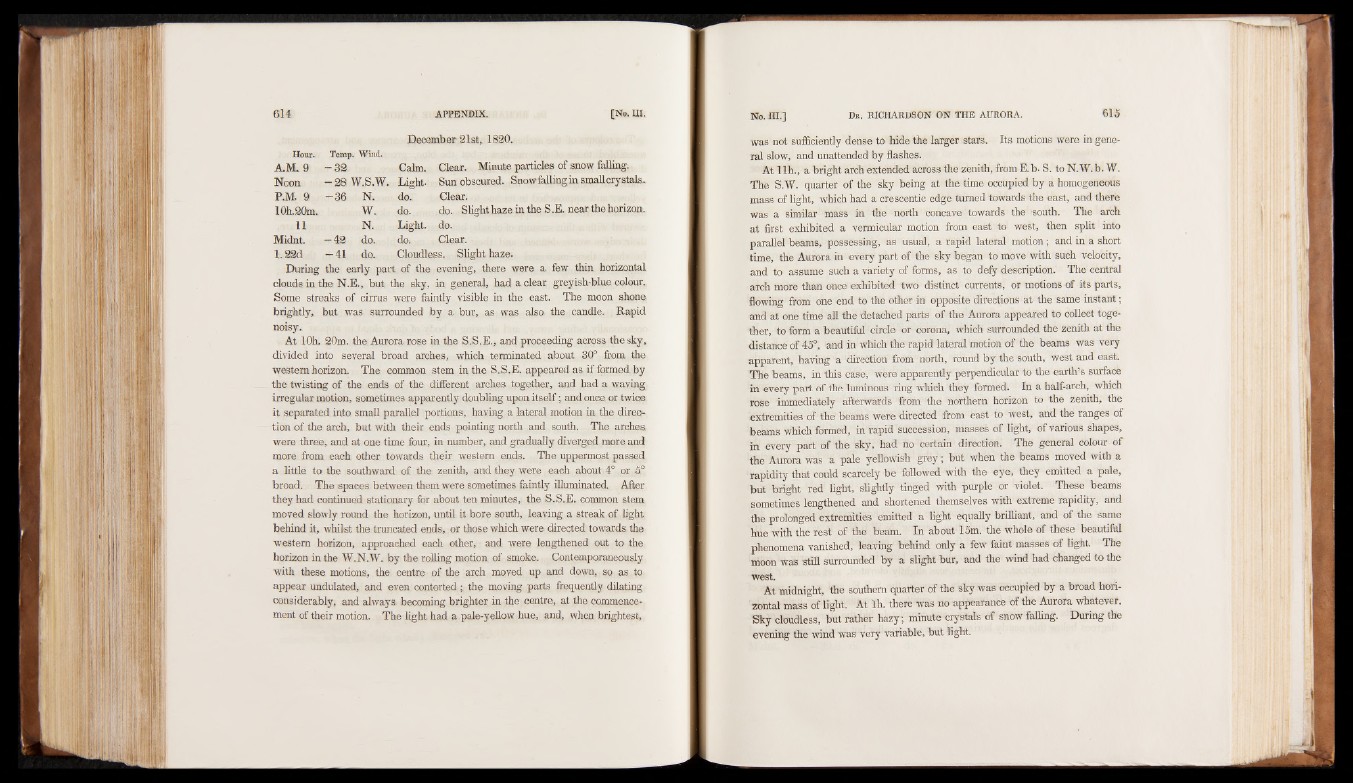
December 21st, 1820.
Hour.. Temp. Wind,
A.M. 9 -3 2 Calm, Clear. Minute particles of snow falling.
Noon - 28 W.S.W. Light. Sun obscured. Snowfallingin small crystals.
P.M. 9 -3 6 N. do. Clear.
10h.20m. w. do. do. Slight haze in the S .E. near the horizon. U N. Light. do.
Midnt. -4a do. do. Clear.
I.22d -41 do- Cloudless. Slight haze.
During the early part of the evening, there were a few thin horizontal
clouds in the N.E., but the sky, in general, had a clear greyish-blue colour.
Some streaks of cirrus were faintly visible in the east. The moon shone
brightly, but was surrounded by a bur, as was also the candle. Rapid
noisy.
At lOh. 20m. the Aurora rose in the S.S.E., and proceeding across the sky,
divided into several broad arches, which terminated about 30° from the
western horizon. The common stem in the S.S.E. appeared as if formed by
the twisting of the ends of the different arches together, and had a waving
irregular motion, sometimes apparently doubling upon itself; and once car twice
it separated into small parallel portions, having a lateral motion in the direction
of the arch, but with their ends pointing north and south. The arches,
were three, and at one time four, in number, and gradually diverged more and
more from each other towards their western ends. The uppermost passed
a little to the southward of the zenith, and they were each about 4° or 5°
broad. The spaces between them were.sometimes faintly illuminated. After
they had continued stationary for about ten minutes, the S.S.E. common stem
moved slowly round the horizon, until it bore south, leaving a streak of light
behind it, whilst the truncated ends, or those which were directed towards the
western horizon, approached each other, and. were lengthened out to the
horizon in the W. N.W. by the rolling motion of smoke. Contemporaneously
with these motions:, the centre of the arch moved up and down, so as to
appear undulated, and even contorted; the moving parts frequently dilating
considerably, and always, becoming brighter in the centre, at the commencement
of their motion. The light had a pale-yellow hue, and, when brightest,
was not sufficiently dense to hide the larger stars. Its motions were in general
slow, and unattended by flashes.
At llh., a bright arch extended across the zenith, fromE.b. S. toN.W.b. W.
The S.W. quarter of the sky being at the time occupied by a homogeneous
mass of light, which had a crescentic edge turned towards the east, and there
was a similar mass in the north concave towards the 'south. The arch
at first exhibited a vermicular motion from east to west, then split into
parallel beams, possessing, as usual, a rapid lateral motion ; and in a short
time, the Aurora in every part of the sky began to move with such velocity,
and to assume such a variety of forms, as to defy description. The central
arch more than once exhibited two distinct currents, or motions of its parts,
flowing from one end to the other in opposite directions at the same instant;
and at one time all the detached parts of the Aurora appeared to collect together,
to form a beautiful circle or corona, which surrounded the zenith at the
distance of 45°, and in which the rapid lateral motion of the beams was very
apparent, having a direction from north, round by the south, west and east.
The beams, in this case, were apparently perpendicular to the earth’s surface
in every part of the luminous ring which they formed. In a half-arch, which
rose immediately afterwards from the northern horizon to the zenith, the
extremities of the beams were directed from east to west, and the ranges of
beams which formed, in rapid succession, masses of light, of various shapes,
in every part of the sky, had no certain direction. The general colour of
the Aurora was a pale yellowish grey; but when the beams moved with a
rapidity that could scarcely be followed with the eye, they emitted a pale,
but bright red light, slightly tinged with purple or violet. These beams
sometimes lengthened and shortened themselves with extreme rapidity, and
the prolonged extremities emitted a light equally brilliant, and of the same
hue with the rest of the beam. In about 15m. the whole of these beautiful
phenomena vanished, leaving behind only a few faint masses of light. The
moon was still surrounded by a slight bur, and the wind had changed to the
weAstt. midnight, the southern quarter of the sky was occupied by a broad horizontal
mass of light. At lh. there was no appearance of the Aurora whatever.
Sky cloudless, but rather hazy; minute crystals of snow falling. During the
evening the wind was very variable, but light.